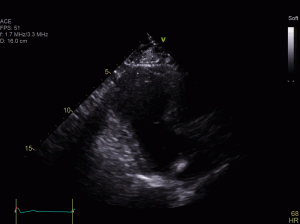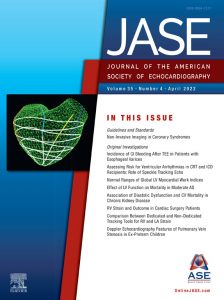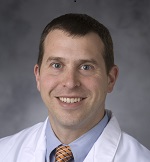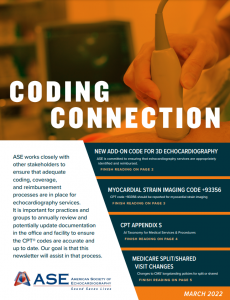ASE is pleased to announce that its membership has elected nine new board members to serve the Society starting July 1, 2022. The 2022 ASE Executive Committee welcomes newly elected Vice President (one-year term) Theodore Abraham, MD, FASE, University of California at San Francisco, San Francisco, CA, and Secretary (two-year term) Kelly Thorson, DHSc, MSRS, ACS, RDCS, FASE, Lucile Packard Children’s Hospital Stanford, Palo Alto, CA.
In addition to the new officers, the following new Board of Directors members were elected to serve two-year terms: Jose Banchs, MD, FASE, FACC, University of Colorado Anschutz Medical Campus, Aurora, CO (Member at Large); Akhil Narang, MD, FASE, Northwestern Medicine, Chicago, IL (Member at Large); Fadi Shamoun, MD, FASE, Mayo Clinic Arizona, Scottsdale, AZ (Council on Circulation & Vascular Ultrasound Steering Committee Chair); Neha Ringwala Soni-Patel, MEd, RCCS, RDCS (AE/PE), FASE, Cleveland Clinic Children’s, Cleveland, OH (Member at Large); and G. Monet Strachan, ACS, RDCS, FASE, UCSD Medical Center, San Diego, CA (Council on Cardiovascular Sonography Steering Committee Chair). Sujatha Buddhe, MD, MS, FASE, Seattle Children’s Hospital, University of Washington, Seattle, WA (Leadership Academy Representative) and Arthur Labovitz, MD, FASE, Naples Cardiac & Endovascular Center (Retired), Naples, FL (Council on Critical Care Echocardiography Steering Committee Chair) will each serve a one-year term.
Previously elected members of the 2021-2022 ASE Executive Committee transitioning to a new position on the 2022-2023 Board are Stephen Little, MD, FASE, Houston Methodist Hospital, Houston, TX (President); Benjamin Eidem, MD, FASE, Mayo Clinic, Rochester, MN (President-Elect); and Raymond Stainback, MD, FASE, Texas Heart Institute, Houston, TX (Immediate Past President). Cynthia Taub, MD, FASE, Dartmouth Hitchcook Medical Center, Lebanon, NH, will continue serving as Treasurer through June 2024, and Keith Collins, MS, RDCS, FASE, Northwestern Medicine, Chicago, IL, will join the 2022-2023 ASE Executive Committee for a two-year term as the Council Representative.
Directors continuing with their final year of service include Carolyn Altman, MD, FACC, FAHA, FASE, Baylor College of Medicine, Houston, TX (Council on Pediatric & Congenital Heart Disease Steering Committee Chair); Anthony Gallagher MHA, FASE, Baptist Health Lexington, Lexington, KY (Member at Large); Leo Lopez, MD, FASE, Stanford Children’s Hospital, Palo Alto, CA (Member at Large); G. Burkhard Mackensen, MD, PhD, FASE, University of Washington, Seattle, WA (Council on Perioperative Echocardiography Steering Committee Chair); Susan Mayer, MD, FASE, Saint Luke’s Mid America Heart Institute, Kansas City, MO (Member at Large); Kian-Keong Poh, MA, MMed, FRCP, FAMS, FAsCC, FACC, FASE, National University Heart Centre, Singapore (International Representative); Thomas Ryan, MD, FASE, The Ohio State University, Columbus, OH (Past President Member); and Vandana Sachdev, MD, FASE, National Institute of Health, Bethesda, MD (Member at Large).
ASE thanks the following eight Board members who will complete their service on June 30, 2022: Meryl Cohen, MD, MSEd, FASE, FACC, FAHA, Children’s Hospital of Philadelphia, Philadelphia, PA (Council Representative); Judy Hung, MD, FASE, Massachusetts General Hospital, Boston, MA (Immediate Past President); Danita Sanborn, MD, MMSc, FASE, Massachusetts General Hospital, Boston, MA (Member at Large); Vincent Sorrell, MD, FASE, FACP ASIM, FACC, FCMR, University of Kentucky Gill Heart & Vascular Institute, Lexington, KY (Member at Large); Jordan Strom, MD, MSc, FASE, Beth Israel Deaconess, Milton, MA (Leadership Academy Representative); Ritu Thamman, MD, FASE, University of Pittsburgh Medical Center, Pittsburgh, PA (Member at Large); Matt Umland, ACS, RDCS, FASE, Aurora Health Care, Muskego, WI (Secretary); and Bryan Wells, MD, FASE, Emory Healthcare, Atlanta, GA (Council on Circulation & Vascular Ultrasound Steering Committee Chair).
The current 2021-2022 Board of Directors will meet for the final time at ASE’s 33rd Annual Scientific Sessions in Seattle, WA, from June 10-13, 2022.

 The CASE Editorial team is excited to announce the latest addition to the CASE homepage, Sonographer Sound-Off. This new interactive element provides an opportunity for sonographers to share tips and tricks they have learned in everyday practice. Congratulations to Agatha Kwon, BSc (Hon), GradDipCardiacUltrasound, The Royal Brisbane and Women’s Hospital, Queensland, Australia, for supplying the images and text for the INAUGURAL Sonographer Sound-Off.
The CASE Editorial team is excited to announce the latest addition to the CASE homepage, Sonographer Sound-Off. This new interactive element provides an opportunity for sonographers to share tips and tricks they have learned in everyday practice. Congratulations to Agatha Kwon, BSc (Hon), GradDipCardiacUltrasound, The Royal Brisbane and Women’s Hospital, Queensland, Australia, for supplying the images and text for the INAUGURAL Sonographer Sound-Off.  The
The 
 ASE is committed to providing our members with the tools and resources needed to ensure they are coding accurately, maintaining compliance with all requirements, and maximizing appropriate reimbursements.
ASE is committed to providing our members with the tools and resources needed to ensure they are coding accurately, maintaining compliance with all requirements, and maximizing appropriate reimbursements. The
The